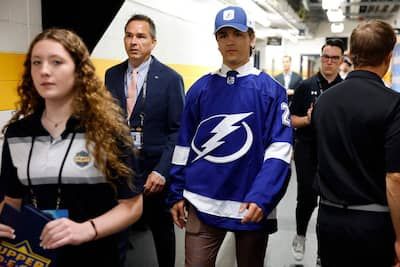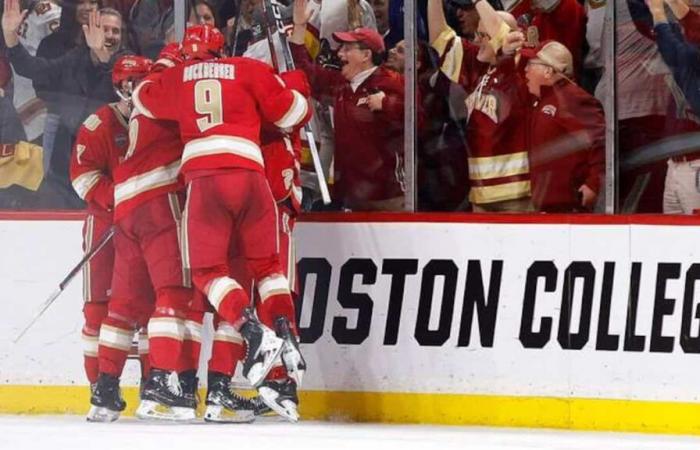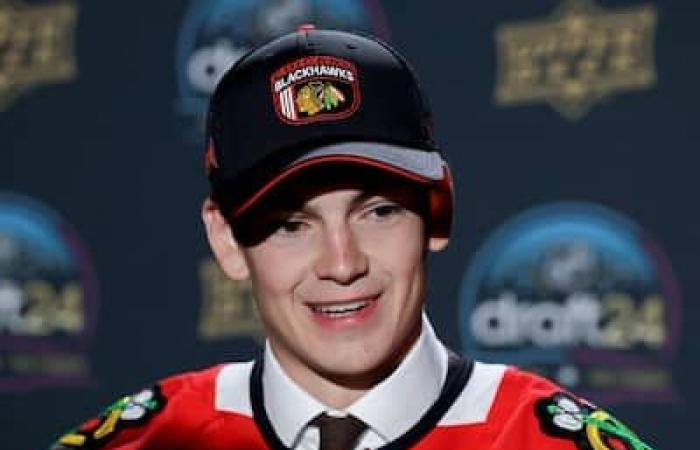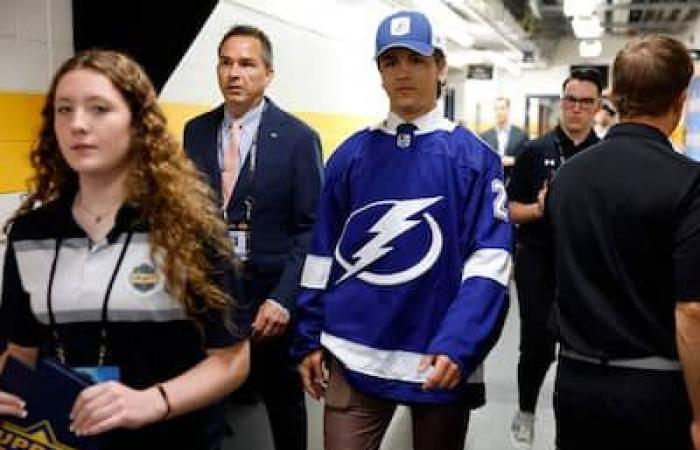The adoption of new regulations by the NCAA now allowing CHL players to join would provide many additional options for players.
The Journal proposed four different scenarios to industry stakeholders in order to understand what new possibilities will be offered to players.
Scenarioo1: a 15-year-old Quebec player, who plays M18 AAA, wants to play in the NCAA.
With different regulations, forward Sacha Boisvert could have played a few seasons in the QMJHL before joining the NCAA, rather than having to go into exile in the United States at a young age.
Getty Images via AFP
Right now: He had to go into exile either in the US or in the BCHL, to maintain his eligibility.
With the new regulations: he will be able to play in the QMJHL and make the jump to the NCAA at 18 or 19 years old.
The subject of “reluctant” players comes up every year before the draft. Currently, a player can report to the camp of a QMJHL team for 48 hours, without playing an exhibition game. After that, if he decides to stay, he loses his NCAA eligibility. The new regulations should therefore ensure that the vast majority of Quebecers who want to go to the United States will still be able to play a few years in the QMJHL beforehand.
This situation, however, could lead to additional challenges for QMJHL teams in how they build their teams. Drafting a talented player knowing he’s at risk of leaving the line before your team matures could be a dilemma general managers face.
All this, in addition to having to deal with American programs who could at any time keep an eye on their best players.
“We’re going to have to sit down together and draw the lines, otherwise, it’s going to be the Wild West,” said the general manager of the Sherbrooke Phoenix, Philippe Sauvé.
Scenarioo2: a 20-year-old, undrafted player finishes his junior internship without a professional contract in his pocket.

20-year-old forward Antonin Verreault could benefit from a relaxation of NCAA rules. Photo provided by the Rouyn-Noranda Huskies
Photo provided by the Rouyn-Noranda Huskies
Right now: he had to either continue in the minor professional circuits or in the Canadian university circuit.
With the new regulation: he will be able to continue his development in the NCAA and hope to sign a contract as a free agent at 22, 23 or 24 years old.
It seems that this category of players is the one that, at first glance, interests American college scouts the most. Already, they are visible in the amphitheaters of Canadian Hockey League teams.
Consequently, the biggest losers from this new rule risk being the courses on the Canadian university circuit which target exactly the same clientele.
Marc-Étienne Hubert, head coach of the UQTR Patriotes, expects that he and his colleagues at McGill University and Concordia University will have to work even harder to keep Quebec talent and brains from this side of the border.
“American universities are not just targeting the same players we are targeting. They also try to come and get those who are already with us. We will therefore have to fight to keep ours.”
At the same time, the project to add Quebec teams to the Canadian university circuit is progressing slowly. More teams would inevitably provide a greater possibility of retention.
“We see it in other sports: the majority of athletes who leave for the NCAA do not return to Quebec,” emphasized Hubert. It’s a brain and talent drain.”
Scenarioo3: a player playing in the Canadian League is drafted into the NHL at 18 or 19 years old.

Players drafted from the CHL like Ethan Gauthier in 2023 could have more options before having to sign their professional contract.
Photo d’archives, AFP
Right now: the team that claimed him had two years to sign him a contract, otherwise he would become eligible for the draft again.
With the new regulations: At 19, he could likely decide to move to the NCAA and get two more years to develop before having to sign.
Currently, a player drafted from the CHL has two years to sign a contract, unlike four for a hockey player recruited from the NCAA. If a player is drafted from the CHL and then decides to go to the NCAA, will he be subject to CHL or NCAA rules? There is a vagueness here, and the agents consulted do not all have the same interpretation.
In Article 8.6b of the NHL Collective Bargaining Agreement, however, it is clearly stated that a player drafted at age 18 and who subsequently leaves “major junior” remains the property of the team that selected him. claimed until the fourth 1is June following his selection. If some agents believe that the situation will have to be clarified in the next NHL collective agreement, scheduled for 2026, Philippe Lecavalier believes that everything is already black and white.
“No one thought about it before because it wasn’t an option and CHL players weren’t eligible. On the other hand, the way it is written, the rules are the same for all junior players.
Remember that the fact that CHL players had to sign after two years worked against them in the NHL draft, especially in the late rounds; with teams preferring to draft players they can evaluate and develop longer before having to make a contract decision.
Scenarioo4: a QMJHL team drafts an American player.

Several American players are drafted annually by QMJHL teams, without ever playing there. This was particularly the case for Jack Eichel, selected in the first round of the 2012 QMJHL draft by the Halifax Mooseheads.
Getty Images via AFP
Right now: the QMJHL teams must try to convince him to come despite an unfavorable pool where renowned universities are located. It almost never happens.
With the new regulations: she will be able to offer him a two-year development plan, at 16 and 17, in a league higher than the USHL or the BCHL, with the option of going to the NCAA afterwards.
The QMJHL no longer attracts American players. It’s that simple. The Quebec circuit cannot compete with the big universities located on the territory assigned to them and where New England players dream of playing.
With a relaxation of the rules in the NCAA, QMJHL teams would now have the opportunity to court American players on their territory by selling them their program as the best to prepare for the NCAA.
In doing so, they could attract them and, in the worst case scenario, see them leave the league after two or three years and, in the best case scenario, make them fall in love with the organization and count on them for their entire junior career .
Certainly, the most cynical will say that this is a situation which will once again favor the biggest markets since it is already the latter which attract the rare Americans to agree to play here. Maybe, but at least the smaller markets will have the opportunity to monetize American players who want to play in the QMJHL, but not for their team.
General managers of the QMJHL have also told us that they have kept a few more American players on their protection list in anticipation of this new regulation.










